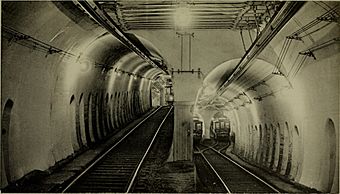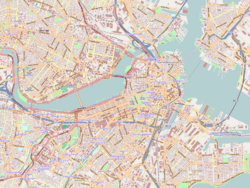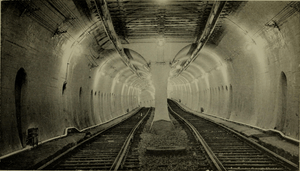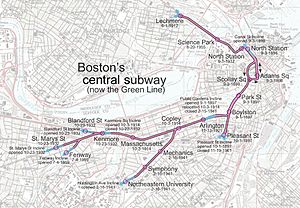Tremont Street subway facts for kids
|
Tremont Street subway
|
|

A flying junction on the now-abandoned southern branch of the Tremont Street subway, south of Boylston station, approaching the Pleasant Street incline (1898 photo)
|
|
| Location | Boston, Massachusetts |
|---|---|
| Built | 1897 |
| Architect | Carson, Howard A. |
| Architectural style | Classical Revival |
| NRHP reference No. | 66000788 |
Quick facts for kids Significant dates |
|
| Added to NRHP | October 15, 1966 |
| Designated NHL | January 29, 1964 |
The Tremont Street subway in Boston, Massachusetts, is a very important part of history! It's the oldest subway tunnel in North America. It's also the third oldest subway in the world that uses only electric power. It first opened on September 1, 1897.
This subway was built to help streetcars get off the busy streets. Back then, traffic was a big problem. The subway helped move people faster. Today, this tunnel is the main part of Boston's Green Line. It connects stations like Boylston Street, Park Street, and Government Center.
Contents
History of the Tremont Subway
When the tunnel first opened, it had five stations close together. These were Boylston, Park Street, Scollay Square, Adams Square, and Haymarket. There were also two branches, one to the Public Garden and another to the Pleasant Street incline.
Over the years, some stations like Park Street, Scollay Square, and Haymarket were changed. This was done to add connections to other subway lines. These lines are now part of the Red, Blue, and Orange Lines.
The original stations at Boylston and Park Street had stone buildings above ground. These buildings were called headhouses. They were designed by Edmund M. Wheelwright. People thought these buildings looked too much like tombs. Later subway stations were built with simpler headhouses.
In 1963, a big change happened in the northern part of the tunnel. This was when the new Boston City Hall was being built. The tunnel going north to Haymarket station was moved. The old Scollay Square station was rebuilt and became Government Center station. Adams Square station was closed down. Parts of the old tunnel were filled in to support the new City Hall. Some parts were even used for storage later on!
In 1971, the original Haymarket station was replaced. A new station was built just south of the old one.
Old Southern Tunnel Branch
In 1897, the subway had a main line under Tremont Street. This line ended at Park Street. But it also had two branches that went south. One branch still exists today. It goes west along Boylston Street towards Arlington station.
The other branch went south under Tremont Street. It led to the Pleasant Street incline. This part of the tunnel was used by streetcars. These streetcars traveled to places like Egleston and City Point. Streetcar service through this southern tunnel stopped in 1962. For a few months, only a shuttle ran between the tunnel entrance and Boylston station.
Today, this old tunnel still exists underground. The entrance has been sealed and is now part of a park. There's a chance this unused tunnel might be used again in the future. There's a plan to create a new streetcar line. This line could help people in southern Boston get to rapid transit again.
Subway Entrances Over Time
The Tremont Street subway originally had three entrances. These were in the Boston Public Garden, at North Station/Canal Street, and at Pleasant Street. As the subway system grew, these entrances were replaced or closed. You can still see parts of some old entrances inside the Green Line's tunnel west of Boylston station.
The Public Garden entrance was replaced in 1914. Two new entrances were built. One was on Boylston Street, and the other was further west. The Boylston Street entrance was closed in 1941. The entrance near Kenmore Square was replaced in 1932. This was when the subway was extended even further west. Today, the top part of the original Kenmore entrance is still there. It's now part of a ventilation shaft. A new entrance for the D branch opened in 1959.
The northern entrance at Canal Street was replaced in 2004. This happened when the subway was extended under North Station.
The southern entrance at Pleasant Street was closed in 1962. This was after streetcar service stopped there. The entrance is now sealed and covered by a park. But the tunnel still exists underground, waiting for possible future use.
How the Subway Gets Power
The subway uses trolleys that run on electricity. This electricity comes from wires above the tracks. These wires were made possible by the invention of the trolley pole in 1880. Since the 1990s, the trains have used a device called a pantograph to get power from the overhead wires.
Special Status and Ownership
The Tremont Street subway is a National Historic Landmark. This means it's a very important historical place. It got this special status because it was a pioneer in building subway systems in the United States. The landmark status includes the parts of the tunnel that are still used today. It also includes the original station buildings at Park and Boylston stations.
The subway was first owned by private companies. These were the West End Street Railway and later the Boston Elevated Railway. In 1947, the subway became publicly owned. It is now managed by the Massachusetts Bay Transportation Authority, also known as the MBTA.







